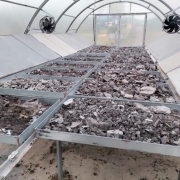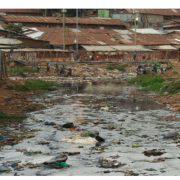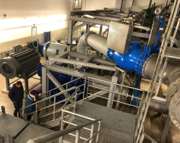As part of the 6th edition of Ask The Experts series themed: “Valorising the end-products of domestic and industrial wastewater treatment” organized on April 25th, 2023, by the African Water and Sanitation Association (AfWASA) in collaboration with the German- African Partnership for Water & Sanitation (GAPWAS), Justina Haihambo, Process Engineer Gammams Wastewater care Works at the City of Windhoek, central area of Namibia gave an insight into Windhoek’s direct potable reclamation.
Windhoek is located in Namibia, the driest country of sub-Saharan Africa, and is also the hub for the country’s economic, industrial, academic, commercial and political activities. The mission of the City of Windhoek is to enhance the quality of life of the population through efficient and effective municipal services and to improve water security. In the last housing and population census, the population of Windhoek was forecasted at 341000 people, but currently at a growth rate of 4.3%, is forecasted at about 441700 people. The annual water consumption of Windhoek is 27 000 000 m3/year, with an annual increase of about 3%. This, coupled with factors below, make the provision of water security of Windhoek uncertain:
- Windhoek has the highest population growth rate that increases the water demand proportionally;
- Windhoek is also synonymous for irregular or erratic rainfall patterns, which result in the lowest average rainfall, for annual rainfall of about 300 to 400mm. A low annual rainfall with the high annual evaporation of about 3000 to 3500mm;
- Windhoek experiences regular drought and the ephemeral rivers that are closed to this city are fully exploited;
- The perennial waters sources that are located closed to Windhoek are too far away. The Okavango River for example is 700km away, and the Atlantic ocean is about 3500km away.
- The main perennial rivers are national borders originating in the neighboring countries, which means that the long- term agreement on water exploitation cannot always be guaranteed;
- The portable water sources closed to Windhoek in close proximity have been fully harnessed.
The timeline of the potable water supply scheme of Windhoek has to be understood and considered in other to aid in understanding how wastewater is or has become a valuable resource toward water security. So, Windhoek was settled in 1840 partly because of the availability of groundwater from permanent hot springs. Until 1960, the city continued to heavily rely on groundwater from a well field for its water supply security, despite the construction of two small state-owned dams build-in ephemeral rivers in 1993 and 1958 respectively. So, meanwhile the population continued to rapidly increase, the city continued to experience regular drought in parallel. Consequently, all water resources at the time became depleted, which made the future of water security uncertain. Heavily relying on too small construction dams in ephemeral rivers and groundwater for water supply led to the fact that in terms of water, Windhoek became vulnerable; thus cementing the idea of unconditional water sources and supply and the idea of direct potable reclamation as well. This led to the construction of a direct potable reclamation plant in 1968 to argument the groundwater and the surface water supply, which at the time had become uncertain and unreliable. So, from 1970 to 1982, the state-owned supply system got extended in a three-dams systems.
From 1990 to present, Windhoek has been relying on what is known as the central area of Namibia supply scheme for its water supply or its potable supply needs. This supply scheme consists of the following:
- First, the groundwater supply and the three-dams system, owned by a state- owned enterprise called NamWater, which is the country national water utility and bulk supplier;
- Second, the reclaimed water or direct potable reclamation, with reclamation of potable water directly from sewage effluent that is produced and provided by a wastewater treatment plant called Gammams water care works wastewater treatment plant.
This direct potable reclamation was constructed at an initial capacity of about 4.8mega liters a day, which got increased over time. But at the end of its lifespan, in the midst of severe drought in 1997 and with lack of a sustainable water supply option at the time, it was decided to build a bigger plant at a capacity of 21 mega liters a day. Another Windhoek sustainable options to reduce the water demand, was the establishment of a semi- purified and irrigation supply scheme. This was established in 1993, with the construction of a dwell pipeline system to convey water from the old direct potable reclamation plant to sports fields of schools and establishment of businesses. This semi- purified water is also used at municipal wastewater purification plant for irrigation and general cleaning of equipment. This irrigation water supply scheme was established to decrease the Windhoek water demand by about 8%.
In another view, the current potable water supply scheme consists of:
- Windhoek is indicated in the green square, central Namibia (See centre of Map 1 in attachment). So, the three- dams system that belongs to the state has the largest capacity; it consists of the Omatako dam (212 km from Windhoek) which is built in the Swakop river. Besides the rainfall, it gets supplemented by a scheme further up north and a state-owned scheme called Von Bach supply scheme from underground water; then the water is pumped into a canal called the eastern national water carrier located 430km away from Omatako dam, and which transports water to Omatako dam.
- Then, the Von Bach dam is about 70km from Windhoek. So, water is pumped from Von Bach dam and is treated in the Von Bach purification plant; the water is then piped to Windhoek for supply. This water is finally blended with the direct potable reclaimed water and or the underground water for distribution.
- The Swakoppoort dam (125km from Windhoek) is the largest one, which is built just downstream of the Swakop river.
Water reclamation or water reuse is known in theory as one of the main alternatives to reduce water demand. Therefore, Chart 1 in the presentation attached shows the annual consumption of water demand by source for Windhoek for the past 55 years. So, in general, the introduction of the direct potable reclamation means that the volume of water required from other conventional sources is reduced, and especially with introduction of the irrigation supply scheme in 1993. Direct potable reclamation also means that in normal metrological conditions, the groundwater can be preserved for use sustainably when necessary; for example, as was the case during the 2013 to 2019 drought, and more notable in 2019 when Windhoek experienced “the worst drought in 90 years” with the lowest average rainfall recorded.
Over the years or the 55 years, the water demand kept increasing proportionally with the growth rate; however, there were some notable reductions in water demands, and the weight of droughts in 1982-1983, 1996-1997, 2013-2019 were mostly attributed to water demand management.
Importantly, the ongoing success of direct potable reclamation can be attributed to correct practices and efficient operations for wastewater treatment. Therefore, if we don’t have efficient wastewater treatment in place, we don’t have direct potable reclamation. Grammans Water Care Wastewater treatment plant is an important component of the ongoing success of direct potable reclamation.
Grammans Water Care Works is a biological wastewater treatment plant that was built between 1959 and 1961 but commissioned in 1963. It was constructed with the initial capacity of 9 megaliters a day, which increased to 25 megaliters a day, its current capacity. It was designed to treat water from domestic origin. The industrial wastewater is diverted to another plant mainly to protect the direct potable reclamation plant from hazardous waste.
This allows to plan for Windhoek and the country, and Gammans serves as an important link in the water circle because it treats water, which is directly reclaimed for potable use, which serves partially towards meeting the water demand of the Windhoek potable water needs.
Chart 2 (see attachment) shows in- flow water into Gammans and then the supply water to the reclamation plant, and the product works into the reclamation plant. Of the effluent water received at Gammams, 75% is supplied to the direct potable reclamation plant. Of the water that is supplied, 85% is the direct potable reclamation plant intakes. of the intake, 92% is produced and then blended with other conventional sources for distribution.
With water reuse being recognized as the main alternative to reduce water demand or water consumption, Namibia as a water-stressed country must find ways to take advantage of all the drops of wastewater to increase the reuse potential. Therefore, another direct potable reclamation project was identified as one of the medium-term interventions to upgrade or improve water security. But for this project to be feasible, additional upgrades are required for the Gammams wastewater treatment plant and another municipal plant, in order to ensure that there is sufficient water at the right quality.







